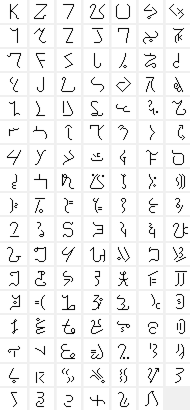"The" Kryptonian Language (?)
The history of the "Modern" Kryptonian language is a somewhat unique one. Just after the formation of the Planetary Federation following the so-called "Final War", one of the first acts of the new ruling Science Counsel was to appoint a committee, headed by linguist Val-Zho, whose purpose was to create a single unifying language for the fledgling government. This was one of many programs enacted by the counsel as part of efforts to rally planet-wide unity and support for the new, and still somewhat tenuous, government.
All languages spoken on Krypton at this time were (to historical linguists) obvious descendants or dialects of one of the five "Father Voices", Kandorian, Vath, Twenx, Urrikan, and Lurvanish. Clearly, all the languages on Krypton belonged to a single language family - truly a testament to the conservative nature of Kryptonians. The language committee, then, had a much easier time creating a unifying language, and met with much greater success, than similar projects attempted on Earth would fare. Subsequently, the council and the language committee were both surprised at the pace and breadth of the new language's adoption.
It is often speculated that the Father Voices were already well on their way to becoming a single language before the efforts of Val-Zho's team - an assertion that draws strong support from both pre- and post-crisis Kryptonian history. This language convergence trend has led some linguists to question whether all of the Father Voices indeed even shared a common ancestor, or whether some or all had different lineages that had been obscured by centuries of linguistic interference.
"Old" vs. "Modern" Kryptonian
Pre-Crisis
Kandorian was the language of the science nation, Kandor, prior to the planetary unification. The circumstances of the planetary unification placed Kandor in the preeminent position amongst the nations; Kandorian became the official language of the newly formed government, and eventually became the planetary lingua franca. Over time, native speakers of other Kryptonian languages dwindled and vanished (with the exception of Vath - owing, assuredly, to the independence of the Vathlo nation).
Post-Crisis
Kandorian, just as in pre-crisis Krypton, was the language of the science nation, Kandor, prior to the planetary unification. However, on post-crisis Krypton, the science council decided to create a new language instead of depending on any existing one. This new language, this "Modern" Kryptonian, took the same course of pre-crisis Kandorian, spreading relatively quickly across the planet as the new lingua franca, while Kandorian quietly vanished with the other Kryptonian languages.
"Modern" Kryptonian Orthography
The Modern Kryptonian writing system, in contrast with the spoken language, was drawn almost exclusively from the single Father Voice of Vath in hopes of greater efficiency and flexibility (they also hoped, in vain, that it would help persuade Vathlo to become a full member of the planetary government). Vath was chosen over the other writing systems primarily because of its clear and distinct alphabet. Vahl-Zho and his team took Vath and reorganized and reduced its character set from forty-seven to thirty-three basic symbols. Over time, these symbols were augmented by several digraphs, ligatures, and ideographs.
The first character of the alphabet, s, was adapted (not unintentionally) from an existing ideograph for "hope" and "wisdom". What was unintentional, though, was the fact that Val-Zho set a precedent with this maneuver that led to the adoption, invention, and introduction of many ideographs into what was initially intended as a simple (and easily learnable) alphabet. It appears that very early in the language's history, perhaps even within the first decade, ideographs were introduced for much of the language's morphological components (particles, verb conjugation, etc.). Over time, Kryptonian ideography became increasingly complex and regionalized; the majority of Kryptonian ideographs were specific to a region, a city, or even a single house/tribe. With the currently limited amount of archaeological sources it is difficult to discern just how many of these ideographs moved beyond the regional status to be adopted into the language proper.
Kryptonese?
Laypersons typically use the term "Kryptonese" to refer to any representation of the Kryptonian language. This term, however, is a technical term used to describe the transliteration of the Kryptonian language into Roman script - just as Pinyin is a method for transliterating Chinese into Roman script. Prior to this work, standardization of Kryptonian to English transliteration has been extremely inconsistent - mostly due to the almost complete obscurity into which the Kryptonian language has fallen. Attempts at Romanization were usually accomplished by the writer trying to represent the sounds of the words (that they were hearing with their own phonetic biases) rather than trying to approximate any Kryptonian written form. The writing section of this site lists the currently-accepted standard Kryptonese representations for each Kryptonian letter or symbol.
Many Kryptonian names have gained fame (or infamy) in Earth languages. It has become accepted practice, then, to use these common spellings when writing English prose where linguistic precision is not required. Some examples: common spelling "Kal-El", "Lara", and "Krypton" are more precisely rendered in the Kryptonese ",kahl,ehl,", ",lahruh,", and ",kryptahn,".




